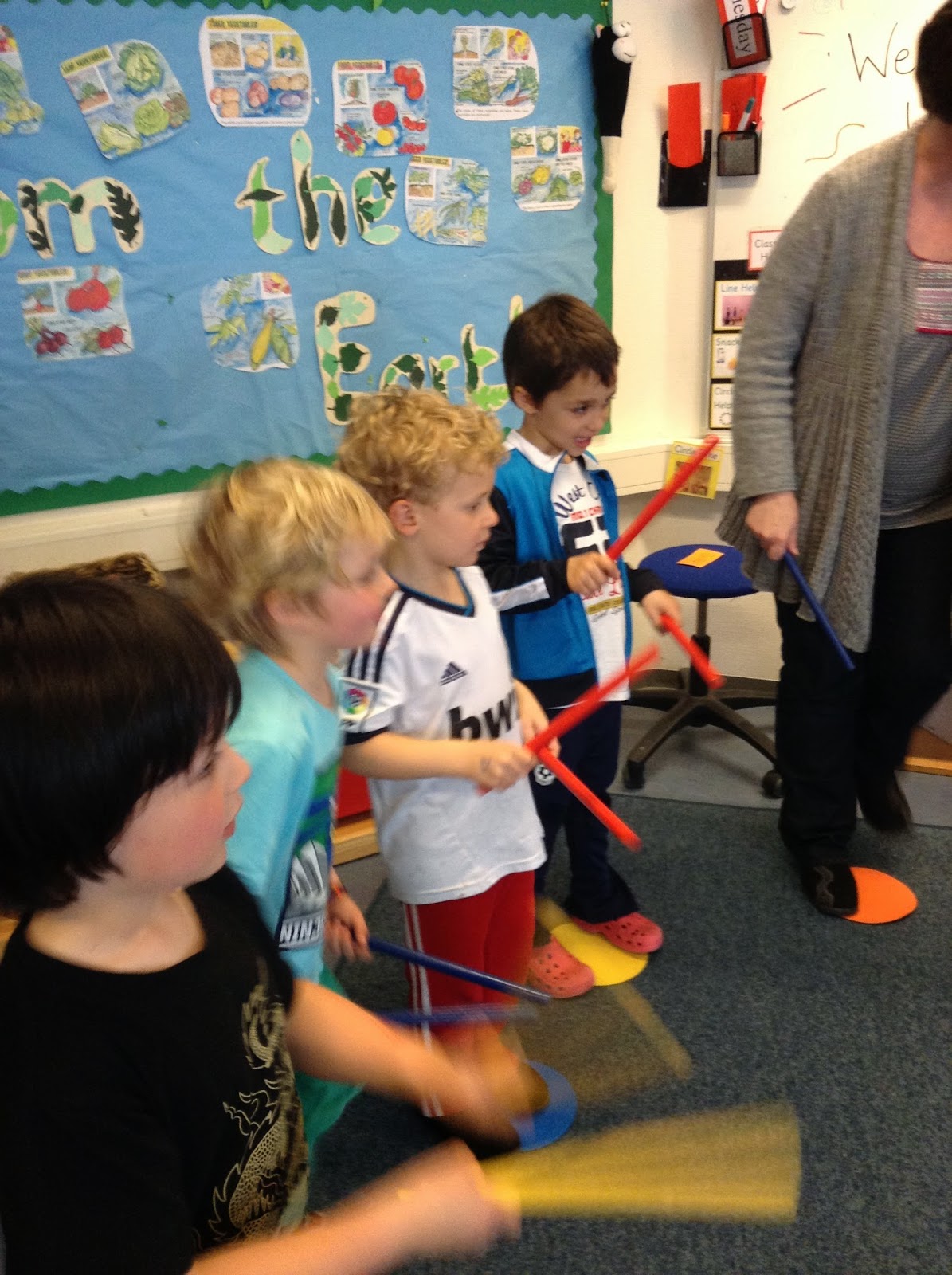Pre-Kindergarten Unit 3 “Playing my part” in a musical setting, defines the musical
exploration activities in Unit 3, “How we express ourselves”. The children
explored fast and slow tempos with the song “Paige’s train” and long and short
sounds in “2 little Sausages”. Musical
cues lead the children to actively respond by jumping, singing, walking or
jogging to the music examples. Haydn’s Surprise Symphony was played giving the children a chance to respond to the short surprise sounds found in the new piece of music. The
children were in fact surprised during the first listening! The children enjoyed story about why Haydn wrote the music. It was to play a joke on the King and his courtiers because they often fell asleep during his concerts. (MU6.PK.B) The children selected instruments they felt reflected the various musical characteristics
of short and long sounds found in the
listening examples and then created accompaniments.(MU2.PK.A) Listening games
like hide the instrument were played and the song "Goldilocks
and the three bears" was added to the class singing repertoire to developed
high, medium and low voice awareness. (MU1.PK.B. Movement games were regularly played
such as Bean bag boogie and Body movements allowing the children
to feel the beat in groups of 8 counts.
“Playing my part” in a musical setting, defines the musical
exploration activities in Unit 3, “How we express ourselves”. The children
explored fast and slow tempos with the song “Paige’s train” and long and short
sounds in “2 little Sausages”. Musical
cues lead the children to actively respond by jumping, singing, walking or
jogging to the music examples. Haydn’s Surprise Symphony was played giving the children a chance to respond to the short surprise sounds found in the new piece of music. The
children were in fact surprised during the first listening! The children enjoyed story about why Haydn wrote the music. It was to play a joke on the King and his courtiers because they often fell asleep during his concerts. (MU6.PK.B) The children selected instruments they felt reflected the various musical characteristics
of short and long sounds found in the
listening examples and then created accompaniments.(MU2.PK.A) Listening games
like hide the instrument were played and the song "Goldilocks
and the three bears" was added to the class singing repertoire to developed
high, medium and low voice awareness. (MU1.PK.B. Movement games were regularly played
such as Bean bag boogie and Body movements allowing the children
to feel the beat in groups of 8 counts.
 “Playing my part” in a musical setting, defines the musical
exploration activities in Unit 3, “How we express ourselves”. The children
explored fast and slow tempos with the song “Paige’s train” and long and short
sounds in “2 little Sausages”. Musical
cues lead the children to actively respond by jumping, singing, walking or
jogging to the music examples. Haydn’s Surprise Symphony was played giving the children a chance to respond to the short surprise sounds found in the new piece of music. The
children were in fact surprised during the first listening! The children enjoyed story about why Haydn wrote the music. It was to play a joke on the King and his courtiers because they often fell asleep during his concerts. (MU6.PK.B) The children selected instruments they felt reflected the various musical characteristics
of short and long sounds found in the
listening examples and then created accompaniments.(MU2.PK.A) Listening games
like hide the instrument were played and the song "Goldilocks
and the three bears" was added to the class singing repertoire to developed
high, medium and low voice awareness. (MU1.PK.B. Movement games were regularly played
such as Bean bag boogie and Body movements allowing the children
to feel the beat in groups of 8 counts.
“Playing my part” in a musical setting, defines the musical
exploration activities in Unit 3, “How we express ourselves”. The children
explored fast and slow tempos with the song “Paige’s train” and long and short
sounds in “2 little Sausages”. Musical
cues lead the children to actively respond by jumping, singing, walking or
jogging to the music examples. Haydn’s Surprise Symphony was played giving the children a chance to respond to the short surprise sounds found in the new piece of music. The
children were in fact surprised during the first listening! The children enjoyed story about why Haydn wrote the music. It was to play a joke on the King and his courtiers because they often fell asleep during his concerts. (MU6.PK.B) The children selected instruments they felt reflected the various musical characteristics
of short and long sounds found in the
listening examples and then created accompaniments.(MU2.PK.A) Listening games
like hide the instrument were played and the song "Goldilocks
and the three bears" was added to the class singing repertoire to developed
high, medium and low voice awareness. (MU1.PK.B. Movement games were regularly played
such as Bean bag boogie and Body movements allowing the children
to feel the beat in groups of 8 counts.




